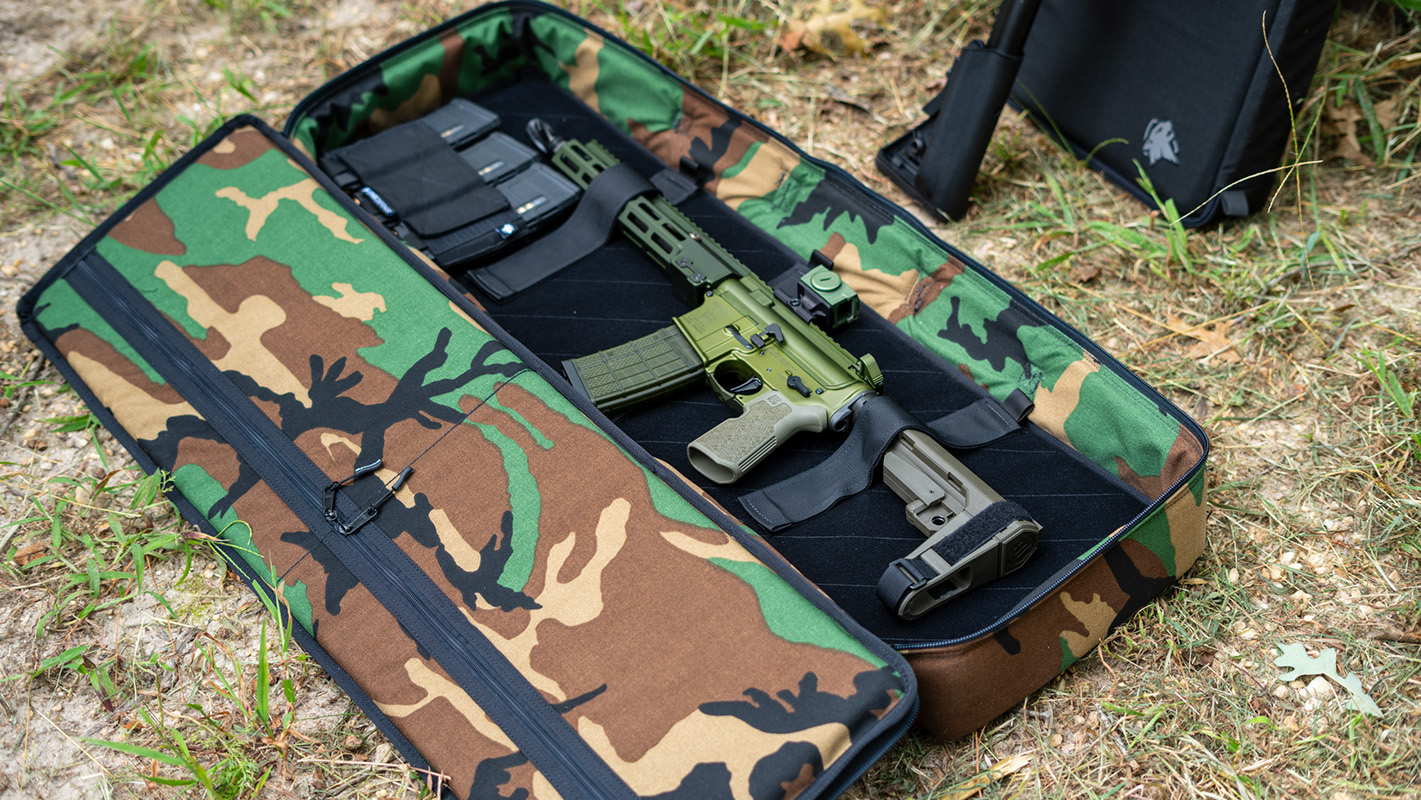
Ready to see what we have coming?
Lynx Defense will release some new things soon. Let us deliver them right to your inbox!

Lynx Defense will release some new things soon. Let us deliver them right to your inbox!
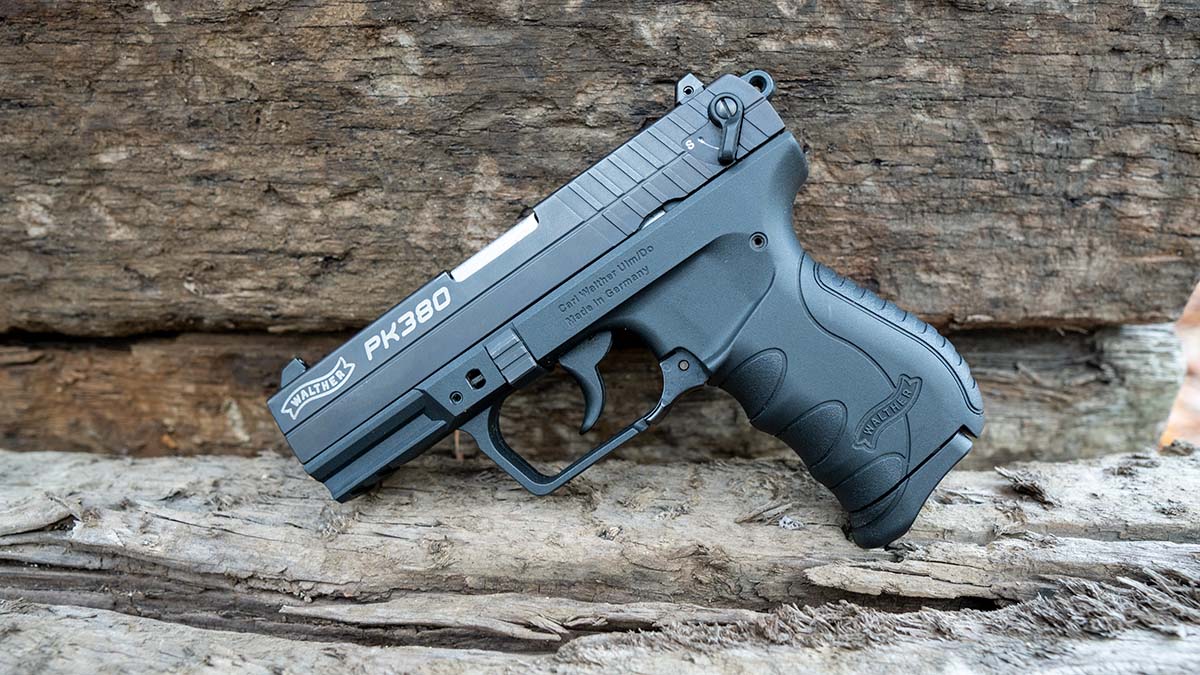
We may earn revenue from product links on this page and participate in affiliate programs. Learn More ›
Saying the Walther PK380 is impressive is an understatement. Unbelievably capable in any situation, this modern fusion of practicality, power, and function is sure to deliver outstanding results with every shot.
As we take a look at this somewhat overlooked offering from Walther, we will evaluate their claims for this .380 ACP pistol.
Walther first emerged in 1886 and was founded by Carl Walther. The roots of the Walther brand, however, go back even deeper to 1780.
Walther first manufactured hunting and target rifles, which they are still known for and continue to produce today.
The manufacturer began to produce self-defense firearms after a merger with another company in 1908. In 1929 Walther began production on the PP line of pistols that would eventually lead to the PPk and PPkS that we have reviewed earlier.
Fast forward to 2002 and Walther has released the P22. The P22 added a modern 22 caliber pistol to Walther’s impressive lineup. Borrowing heavily on the design aesthetic of the P99 the Walther P22 was viewed by many as a smaller practice or plinking pistol.
So you now have the Walther P99 and the Walther P22 chambered in 9mm and .22 cal respectively. This still left the middle ground open, and as many manufacturers so often do, Walther wanted to cover all of their bases.
Enter the Walther PK380 chambered in 380 ACP.
The design and construction of the Walther PK380 is clearly a mirror of both the P99 and the P22. When placed side by side, the PK380 is a scaled down version of the P99 and when placed next to the P22, a scaled up version.
Another way to look at it is Goldilocks and the three bears. The P99 is too hot, the P22 is too cold and the PK380 is just right… for those that prefer the 380 ACP anyway.
The overall construction of the Walther PK380 is very solid. The model I have in my collection is all black.
The polymer used has a decent texture without going overboard, and the slide is coated stainless steel.
All components are well finished and seem to be on par for Walther handguns.
The grip on the PK380 is much larger than you would typically expect to find on a handgun in 380 ACP. It is both taller and thicker than most offerings from other major manufacturers.
The grip has large finger grooves that help center your fingers around the grip in a way that assists your overall combat grip. This is a feature that some people love, and some people hate. I’ve found that with my average sized hands that finger grooves really don’t do much for me but also don’t hinder me in any way.
The grip is extremely smooth when compared to newer offerings even from Walther. When this pistol was first introduced the fad of heavily stippling a pistol had not come around quite yet.
There are Walther branding markings on the lower portion of the grip, using the waving banner with Walther’s name inside.
Something typically found on hammer-fired handguns but conspicuously missing here is a beavertail.

Beaver tails are helpful to keep the web of the hand down and out of the way of the hammer and to a lesser degree, the slide.
Walther decided to not use this feature on the PK380. Walther did however make the inside of the grip further under the slide but this, in turn, raises the overall bore height as the slide still has to reciprocate above the grip/hand.
As stated above, overall texturing on this Walther PK380 is lacking.
If you absolutely need to have more texture, there are some options for you to look at.
First, you can purchase a grip sleeve to slide on the outside of the grip to provide more texture. This is a good non-permanent option for those that want to be able to return their Walther to factory condition.
Second, you can break out a tool for stippling. Most people choose to use a soldering iron for this task. If you choose to stipple the Walther yourself just be aware of the depth of the polymer and the overall heat of the iron.
Third, you can find a company to send your frame off to and have it stippled professionally. This is probably the safest (and smartest) option if you haven’t had lots of practice doing stippling before.
The sights that come standard on the Walther PK380 are not bad. They are made of metal and are sturdy.
The front sight is fixed, and thus all the adjustment for windage has to be made at the rear sight. The rear sight is driftable and sits in a dovetail.

The front sight is swappable for a taller height so if you wish to adjust your point of aim/point of impact you can do that as well.
The sights use a traditional three-dot system. Each dot is large and brightly colored with wight paint.
The distance between the rear sights is abnormally large. I have not had any trouble with these sights, but they are noticeably larger than other manufacturers’ sights.
There are aftermarket options available if you decide the stock sights just aren’t for you.
As observed with the Walther PPK/s we reviewed late last year, the Walther PK380 also has what would initially appear to be a deficiency in the control department.
There is no external slide stop/slide lock. The slide stop is still there, it’s just internal. To lock the slide to the rear, simply fire all the rounds out of the magazine or remove the loaded mag and the round from the chamber and insert an empty magazine. Next rack the slide with the empty mag inserted into the magwell and the follower will push the internal slide stop up and the slide will lock back.
To allow the slide to return home, remove the empty magazine and rack the slide or after removing the empty mag, insert a loaded mag and rack the slide. Both of these operations will allow the slide to return to battery.
Following this form factor, allows Walther to streamline the PK380 for new shooters who may get caught up with a lot of external controls.
The trigger setup for the Walther PK380 is a double-action/single action combo. This means that with the hammer down, the trigger will be double action. When pulled, the trigger will first cock the hammer and then release the hammer to strike the firing pin.

In single action, the hammer will already be cocked either by a previous action of the slide or by the shooter’s thumb. The only action the trigger will perform here is to release the hammer from its precocked position.
The trigger pull in double-action is long but not too heavy. Once the initial take-up is pulled the rest of the travel is smooth with constant pressure until the trigger breaks.
In single action, the initial takeup is minimal, less than a mm. Once the wall is hit the trigger breaks clean and is light.
This setup is common among self-defense handguns.
Being a DA/SA handgun, there is an external safety on the Walther PK380.
The safety location is found on both sides of the PK380’s slide. This seems to be a holdover from the Walther PP line of pistols. There are a few other manufacturers that also use a physical safety on the slide, but it is not a popular location overall.
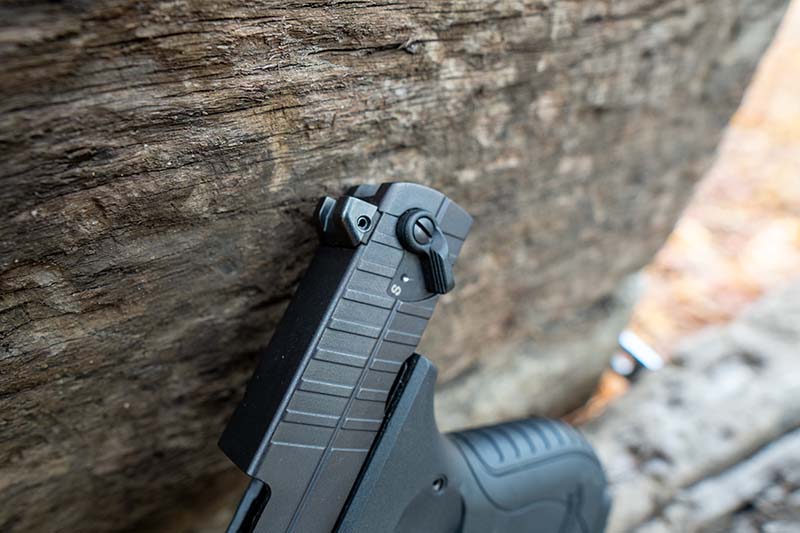
To turn the safety on you need to flip the lever down toward the frame of the handgun. This allows a wedge to come between the hammer and the firing pin preventing them from making contact.
To disengage the safety, simply flip the lever up so it is in line with the barrel of the Walther PK380. The Walther PP, PPK, PPK/s, and other variants all use this style of safety.
Unlike the PP series, this safety does not also function as a de-cocker. I feel like this would have been a nice added function.
Here we part ways with tradition. The Mag release is a paddle design that is located at the bottom of the trigger guard. Although it is not a traditional styling, it is relatively easy to use as its location is in the same general place.
By using a paddle-style mag release in conjunction with the lack of external slide stop and ambidextrous safety, the Walther PK380 can boast that it was one of the first fully ambi pistols to market.
Like the PP series, The Walther PK380 has an internal slide stop. This is obviously different from almost all semi-auto handguns in the modern era. To lock the slide to the rear you must have an empty magazine inserted into the magwell.

This also means that you can not send the slide home using the nonexisting lever. To make the slide go home you must either remove the empty magazine and rack the slide, or insert a loaded mag into the magwell and then rack the slide. As stated in our PPkS review this quirk, while interesting, can be overcome with a proper amount of time and training.
The barrel of the Walther PK380 is stainless steel. The barrel hood is polished. The barrel itself is coated in a melonite-like finish.
The Walther PK380 has a barrel length of 3.66 inches. This is a good length for a 380 ACP self-defense pistol.
In compact pistols, the longer the barrel is the faster the bullet will be able to travel (to a point). Being chambered in 380 ACP allows the bullet to get as much speed as possible in the size allowed.
Magazine capacity on the Walther PK380 is 8 plus one. The taller grip allows Walther to squeeze one more round into the mag than you normally find on a 380 ACP handgun.
The mags themselves are single stack and constructed out of steel. I received two mags in the box along with the PK380. The mags are marked with Walther’s roll mark and the model of the gun. In addition to this, it also states the caliber, Made in Germany, and a unique number for the mag.

The mags have witness holes to allow you to see how many rounds you have left in the magazine. This is a neat feature that is often overlooked on small pistols.
The magwell is very large, so large in fact that if you were to remove the internal ribs that help center and guide the magazine you could fit a Sig P365 magazine inside.
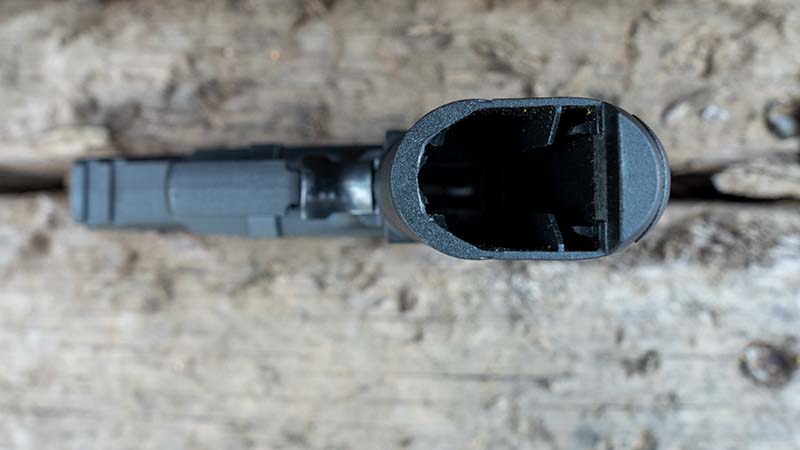
I would like to see Walther revisit this handgun and make it into a stack and a half mag like so many of the micro 9mm currently on the market have done. This is not out of the realm of possibilities.
When shooting the PK380 it handles like a larger firearm. This is mostly due to its larger dimensions when compared to other 380 offerings.
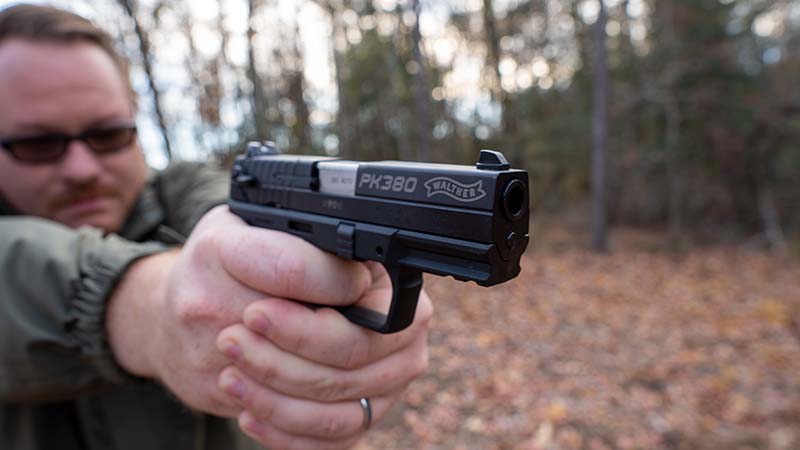
The grip size and length allow you to get a full purchase on the pistol and have maximum control of the firearm while shooting.
These things when combined with the fact that it is chambered in 380 ACP allow for quick and accurate shots on target.
The PK380 is rather large for a 380 ACP handgun. This, however, does not mean that you can’t conceal it. Several options for in waistband holsters are available, along with outside the waistband and off-body options such as in a purse or fanny pack.
Walther included a two-position 1913 rail below the barrel of the PK380. Walther also has a package that comes with a laser if you are into that sort of thing.
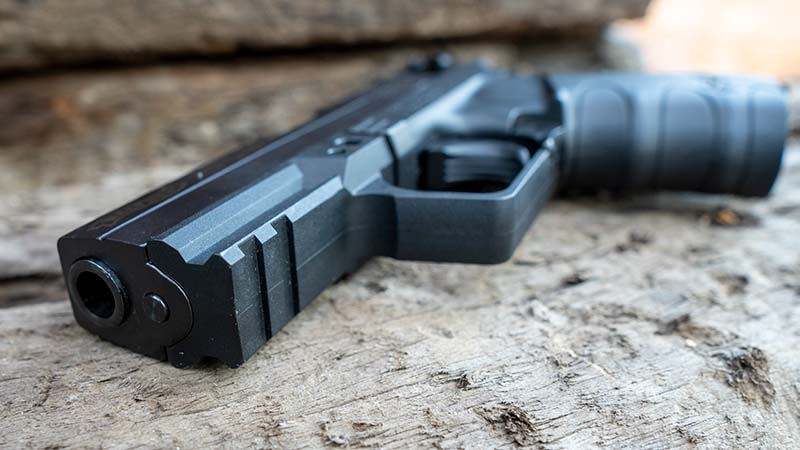
The pic rail is long enough to fit a decently bright light underneath. If you are considering the Walther PK380 for self-defense I would suggest this along with an off pistol or handheld light for use when you’re not wanting to destroy what you are pointing your light at.
Using a pistol mounted light in a situation that does not require use of the handgun is always a no-no.
Taking the PK380 apart is interesting. It follows the same basic principle as its little brother the Walther P22. You have to use a key that is supplied with the PK380 to accomplish this.
First, make sure the gun is unloaded. Next place the safety in the “on” position and place the hammer down.
Insert the key into the hole found on the left side of the pistol just in front of the take down block. Turn the key until it prevents you from turning any further.
Then pull down on the block that is just in front of the trigger, on the frame inside the trigger guard.
Once you have completed these steps, pull the slide forward and it will come off the frame.

After you have removed the slide from the frame, continue to take down the pistil by removing the guide rod and recoil spring, then pop the barrel out of the slide.
Pricing for the Walther PK380 is around $420.00 on Guns.com, depending on the model.
Speaking of models, Walther offers the PK380 in a surprising array of color options, most of which seem to be geared to women. Whether you are looking for a cheetah print grip, Muddy Girl Mossy Oak camo, or a range of pastel pinks, purples and blues can be had on the Walther PK380.
The PK380 seems to be geared toward shooters who need a concealed carry handgun, but might not be comfortable with a smaller option or one that has higher recoil often associated with higher calibers or small frames.
Becuase 9mm typically has more recoil than 380 one might pick the PK380 over a 9mm option, if you want to learn more take a read of our 9mm vs 380 article.

While the color options may come as a surprise to some, I feel this is a natural landing spot for the Walther PK380. Its overall simplicity, size, and ease of racking the slide lend it to be a good fit for female shooters who want a semiautomatic pistol.
Like many other offerings from Walther, the PK380 is a classic.
If you are in the market for a 380 ACP pistol also check out my Kahr P380 Review as well as the Bersa Thunder 380.
Concealed Carry Insurance
Protect yourself and all those who carry concealed in your house.